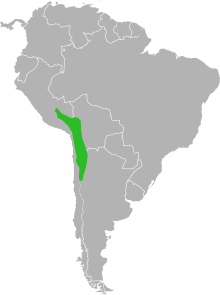| Short-tailed chinchilla | |
|---|---|

| |
| Scientific classification | |
| Domain: | Eukaryota |
| Kingdom: | Animalia |
| Phylum: | Chordata |
| Class: | Mammalia |
| Order: | Rodentia |
| Family: | Chinchillidae |
| Genus: | Chinchilla |
| Species: | C. chinchilla
|
| Binomial name | |
| Chinchilla chinchilla (Lichtenstein, 1829)
| |

| |
| Past range of Chinchilla chinchilla. | |
| Synonyms | |
| |
The short-tailed chinchilla (Chinchilla chinchilla) is a small rodent part of the Chinchillidae family and is classified as an endangered species by the IUCN. Originating in South America, the chinchilla is part of the genus Chinchilla, which is separated into two species: the long-tailed chinchilla and the short-tailed chinchilla. Although the short-tailed chinchilla used to be found in Chile, Argentina, Peru, and Bolivia, the geographical distribution of the species has since shifted. Today, the species remains extant in the Andes mountains of northern Chile, but small populations have been found in southern Bolivia.
The short-tailed chinchilla is characterized by its grayish-blue fur which is extremely dense and plush. The short-tailed chinchilla has a short furry tail, which distinguishes it from the long-tailed chinchilla. Compared to C. lanigera, C. chinchilla has smaller, more rounded ears[4] and is slightly smaller in body size.
Chinchillas have been exploited by humans for centuries. Commercial hunting of short-tailed chinchillas for fur began in 1828 in Chile, leading to an increased demand in Europe and the United States. As the demand for chinchilla pelts rose, the species number declined, leading to the species' apparent extinction in 1917. In 1929 a ban against hunting chinchillas was enacted, but not strictly enforced until 1983.[5] Despite the species' rediscovery in the wild in 1953, the population of short-tailed chinchillas has continued to decline and has been categorized as endangered. Numerous threats to short-tailed chinchillas exist, including illegal hunting, habitat loss, firewood harvesting, and mining.[4] In the last few decades, chinchillas have become increasingly popular as exotic pets, which has led to an increase in hunting and trapping.

- ^ Roach, N.; Kennerley, R. (2016). "Chinchilla chinchilla". IUCN Red List of Threatened Species. 2016: e.T4651A22191157. Retrieved 30 January 2020.
- ^ "Appendices | CITES". cites.org. Retrieved 2022-01-14.
- ^ Domestic specimens of Chinchilla spp. are not subject to the provisions of CITES.
- ^ a b "Chinchilla | San Diego Zoo Animals & Plants". animals.sandiegozoo.org. Retrieved 2022-10-27.
- ^ Jiménez, Jaime E. (1996-07-01). "The extirpation and current status of wild chinchillas Chinchilla lanigera and C. brevicaudata". Biological Conservation. 77 (1): 1–6. Bibcode:1996BCons..77....1J. doi:10.1016/0006-3207(95)00116-6. ISSN 0006-3207.
